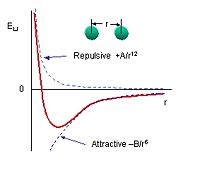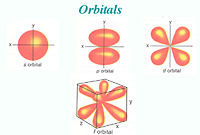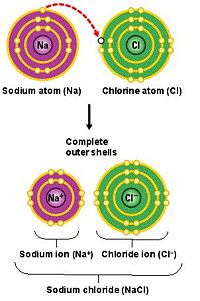PHZ3400-09 Atoms
Please add pictures, as apporpriate, with captions, through cut-and-past from PDF files or from other Web downloads.
Van der Waals Force
The Van der Waals Force, also known as the London Force, arises when two inert atoms bond. Inert atoms have filled electron shells, are very stable, and only affected a small amount when bonding to another inert atom. They act as if they are solid spheres. The bonding of the atoms is highly dependent upon the distance that separates them and can be described by the Lennard-Jones potential. When the atoms are separated by a large distance, the atoms are attracted because they induce an electric dipole moment on each other and become polarized. When the atoms are too close together, the repulse each other because of the Pauli Principle which does not allow two electrons to occupy the same quantum state.
Atomic Bonding: Chemistry Recap
From chemistry we should remember that electrons form orbitals around the nuclei of atoms. The electrons form their shells in a specific order: 1s, 2s, 2p, 3s, 3p, 4s, 3d, 4p, 5s, 4d, 5p, 6s, 4f, 5d, 6p and so on.
Ionic Bond
Ionic bonding is characterized by a greedy atom who steals and electron from another atom. For example, a Cl atom, with one 3s electron outside a filled shell, steals an electron from a Na atom, which lacks an electron for a filled 3p shell, forming Cl- and Na+. The energy lost in this exchange is recovered by moving the ions close together in order to increase their Coulomb potential forming NaCl. If the ions move too close together, their electron will overlap forcing Na's electrons in the 2p shell to move up to the 3p shell or higher to accommodate and this takes energy. This energy might be thought of as a potential of repulsion and increases as the separation between the ions decreases.
Covalent Bond
The atoms involved in a covalent bond share electrons. Ideally, the electrons are shared equally, but the atoms must be identical for this to be true. Most often, the electrons will reside nearer to one of the nuclei. For example, in the semiconductor GaAs, the shared electrons are located nearer to As than Ga. This illustrates the state in which some compound form bonds that are not purely covalent nor ionic, but in some state between. The bond between GaAs is 66% covalent.
- It would be nice to add here a discussion of various SP hybrids leading to different bonding schemes for carbon. If possible, a separate page devoted to organic molecules or even polymers, based on the above.


